
Original Link: https://www.anandtech.com/show/2313
Zippy Serene (GP2-5600V)
by Christoph Katzer on September 3, 2007 1:00 AM EST- Posted in
- Cases/Cooling/PSUs
Intro
With this review of the Serene we now have our second Zippy power supply for review. For those unfamiliar with the company and its roots, we suggest reading our first Zippy review as well. Zippy has been around for quite some time and in the server world they are recognized as having one of the highest qualities available in the market. Zippy is located in a suburb of Taipei called Xin Dian (Hsin Tien) and manufactures all of their power supplies in their factory over there.

They are known for having extremely reliable server power supplies, but recently Zippy has made the step into the retail desktop PSU market with several high class offerings. The Gaming G1 power supply in our last review exhibited very high quality, but it could still use quite a bit of improvement in order to better target the retail desktop PC market. Today we will be looking at the Serene 600W (GP2-5600V), a power supply that was built with the goal of having the best efficiency possible. The package claims 86%, which is quite a lofty goal for a retail product.

As we have seen many times with other power supplies, the Serene comes with a single 12V rail. We have written previously that this does not conform to the actual Intel Power Supply Design Guidelines, but as we have seen, readers and manufacturers have a different opinion about this issue. While some say it is no problem at all - there will be enough safety features that will kick in before something bad happens, i.e. overloading the power supply - the other half prefers to stick to the rules and have released power supplies with up to six 12V rails. While the lower voltage rails have each 25A on disposal, the single 12V rail has 40A and should have no difficulty powering everything a decent system needs.
Given the name, one area that will be of particular interest to us is how quiet this power supply manages to run. Granted, delivering a relatively silent power supply that provides 600W is going to be a bit easier than making a "silent" 1000W power supply, but we still need to determine whether or not the Zippy Serene can live up to its name.
Package and Appearance

The Serene comes in a similar box similar to the G1, and we need to complain about the same issue again. The box is a little too small for this PSU and therefore the two pins that hold the hook press against the box. We also didn't find any protective foam which could protect the power supply against force from outside. This means if the box is dropped or banged around during shipping, it is very likely that the PSU will have some form of damage. On premium priced power supplies, we feel that manufacturers need to hold themselves to a higher standard on packaging.

When companies target the high-end enthusiast market, there are often expectations about what is necessary as well is what is actually required. Many enthusiasts appreciate getting some extras, but at the same time there are others that already have all the zip ties, badges, lanyards, etc. that they need -- anything else is just clutter and extra cost that could have been spent on improving the quality of the primary component. Zippy chose to target the latter group of enthusiasts, and we found just the needed items for installing this PSU. Hopefully that means that Zippy focused more on the inside of the PSU, which is a perfectly acceptable approach if it holds true.

Looking at the PSU, this certainly seems to be the case. It comes in a very simple black color and the focus is on quality and performance rather than flash. A little green LED on the rear serves as a quick temperature gauge: if it's green then everything is supposedly okay. It doesn't appear to change color, and we didn't ever see it turn off during testing regardless of the ambient temperature, but perhaps we just didn't let things get hot enough.


The Serene comes with a single 80mm fan that pulls air through the power supply. On the other side we can see openings so the air can enter the PSU. Unfortunately the openings are just on the middle section and to the right. On the left side there are no openings that could let some fresh air cool down the capacitors and coils of the secondary side.

The Serene has a slightly different fan mounted than the G1 does. With just 0.11A the fan will run a little quieter than what we saw with their Gaming G1. Part of the reason for the different fan is related to efficiency: given two 600W power supplies, the one with higher efficiency will not get as hot as the one with lower efficiency. There is less heat generated and therefore a slower fan can be installed, which naturally should produce less noise.
Cables and Connectors

As we saw with the G1, the cables are all sleeved up to the first connector. This makes sense as it's generally the longer cables contributing to the cable salad and not the shorter ones. The sleeve starts outside of the PSU casing, however, which looks a little bit cheap. It would be better to have the cable ties and sleeve ends inside of the PSU to make a better impression on the users.
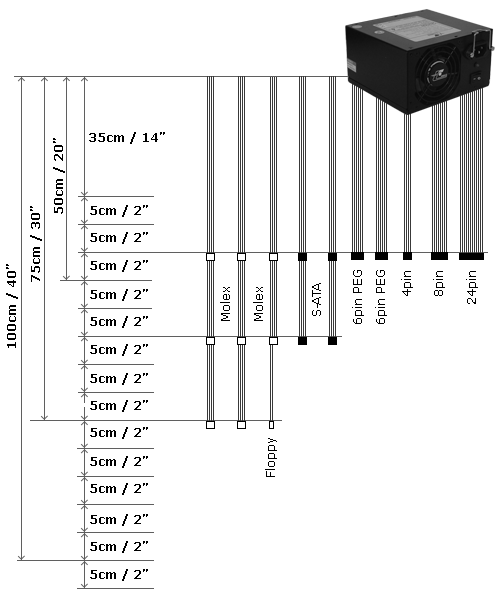
The cable lengths are pretty average, with the first connectors starting at about 45cm. The SATA, Molex and Floppy connector have the longest lengths of 75cm, which won't be a problem with most cases. The two 6-pin PEG connectors are enough for a middle classed system. We would have liked to see at least one 8-pin PEG connector, as a 600W is more than capable of handling a decent high-end PC.
The Hook

The hook for the power cord was a great idea and is implemented in all of Zippy's retail products. You just plug the cord in and slide the hook over it. Afterwards, it would require quite a bit of force to remove the cord, so accidental disconnects will hopefully be eliminated.


The hook is designed to work with the included power cord from Zippy since it has the correct shape. As seen in the second picture, it does not work with some other cords, so if you like the feature you will want to make sure you use the correct cable.
The Inside - Primary Side

Once open the inside reveals very limited and packed space. The heatsinks are mostly located directly behind the openings in the back, allowing them to immediately catch the incoming air and get optimal cooling. The entire secondary side looks very packed and there's little room left for airflow to cool down the components in that area.
Directly in front of the fan is a coil that's part of the primary side's PFC stage. This coil sits directly in front of the fan and blocks a fair amount of space. We have to wonder how much turbulence is caused by this design, since the rectifier bridge is also located beside this coil and blocks additional airflow with its cooler.
It's quite clear that with this topology Zippy isn't able to fit a 12cm fan into the chassis. If it were located above all the components there really wouldn't be any space for the air to come out of the PSU. As it stands, there is still space above the coil and rectifier bridge to allow the air from the heatsinks to reach the exhaust.



The filtering stage looks to be of the utmost quality, and we can see all of the components needed for filtering.


The PFC IC is wrapped in a yellow sheath, whether for protection or for some other purpose we're not sure.

The main capacitor is made by Nippon Chemi-Com, a Japanese company regarded as producing some of the best capacitors in the industry.
The Inside - Transformers

The transformers are located under the large secondary heatsink and therefore not very visible. The standby transformer sits directly beside the large one and supplies the 5V standby rail.
Secondary Side

The secondary side is quite packed like the rest of the inside. Capacitors seem to be sprouting like mushrooms from the PFC, since the cables don't leave much space and push them to the side.

The little extra PCB contains a chip from Weltrend, a Taiwanese semiconductor manufacturer. We couldn't find any information about this chip since it's not listed on the company's website, but similar model names to this WT7507 indicate that it most likely has the safety feature monitoring like OVP and OCP on it. It should also contain the PWM controller which is needed to control the DC outputs of the PSU.

In the center of the picture above you will see an "all solid" capacitor (technically a "Conductive Polymer Aluminum Solid Capacitor", but we will simply abbreviate it here) which is different from a conventional electrolyte capacitor. We have seen these capacitors on graphics cards for a long time, and manufacturers of mainboards have switched to them as well for some products. Power supplies are beginning to use them too, since SeaSonic has also started already to use them for the S12-II series (which we will cover in our next PSU review). Benefits from the solid capacitors are a much longer life expectancy, reliability, and stability. All solid capacitors use a polymer instead of electrolyte and therefore they cannot leak. We have seen many leaking/broken capacitors in the past, particularly in power supplies, since they are one of the first components to fail in a hot environment like a power supply. This also means that these solid capacitors can withstand much higher temperatures than conventional electrolyte ones, and that they can generally last longer at lower temperatures.


Unfortunately, we found a problem with the Serene that is something we complained about in the G1 review. The outgoing cables aren't connected to the housing of the power supply, which means that if you handle it a little rough some of the cables could come loose at the PCB. We hope that this will be solved in later models, since it's not rocket science to attach an additional cable tie.
Test Setup
As usual we are testing with our Chroma programmable loads to fully load each rail to a specific amount. This is important to get truly accurate results and not merely approximate values. The tests are conducted in two different temperature environments. One is normal room temperature of 25-26°C, while the second environment goes from room temperature and increases steadily up to 50°C. Especially during the higher temperatures we will see how good the power supplies are and what they're really made of. Components inside will perform much worse at higher temperatures, but we expect any good quality PSU to deal with such test conditions without failing.
Note: If you would like to know more about our testing methodology, equipment, and environment, please read our PSU testing overview.
| DC Outputs | ||||
| PSU Load | 3.3V | 5V | 12V | Wattage (All Rails) |
| 10% | 1.54A | 1.54A | 3.83A | 60W |
| 30% | 3.08A | 3.08A | 11.49A | 180W |
| 50% | 7.69A | 7.69A | 19.15A | 297W |
| 80% | 12.30A | 12.30A | 30.64A | 470W |
| 100% | 15.38A | 15.38A | 38.30A | 584W |
To provide a better overview about the different temperatures and input voltages we test we have decided to combine the input voltages into on graph and not four single ones. In the future you will see the area in which the voltages have been measured. We have seen in past reviews that the voltage drops have shown very similar results and with this new graph it will be even better to see in which spectrum the voltage is contributing. The graph will show one big line. The distributed measured voltage has been inside of the specified area.
3.3V DC Output
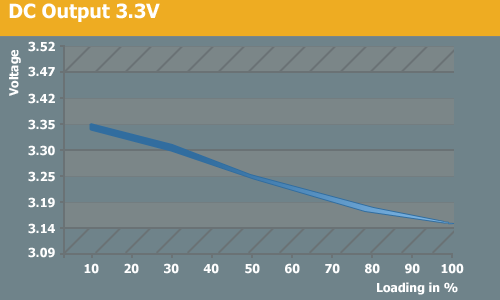
5.0V DC Output
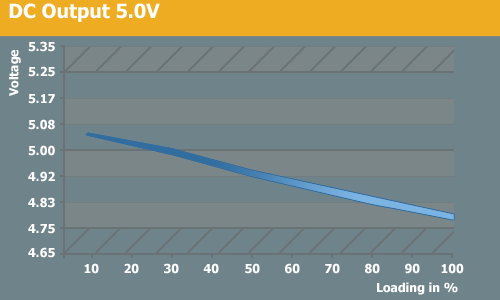
5.0Vsb DC Output
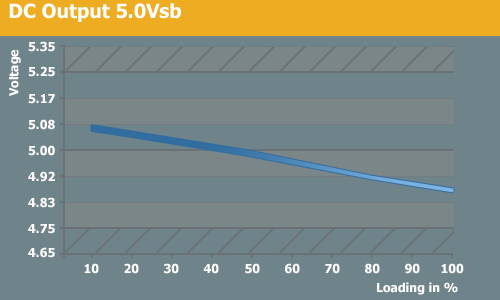
12V DC Output
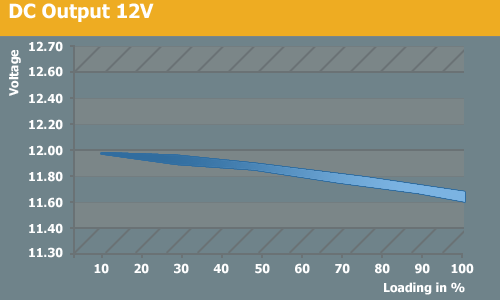
Standby Efficiency
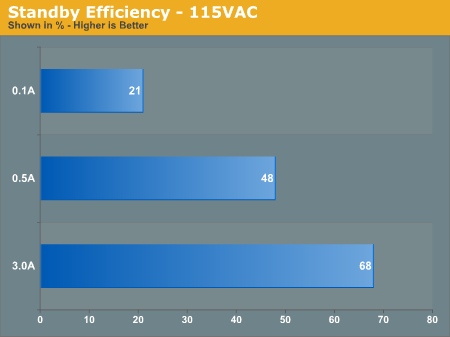
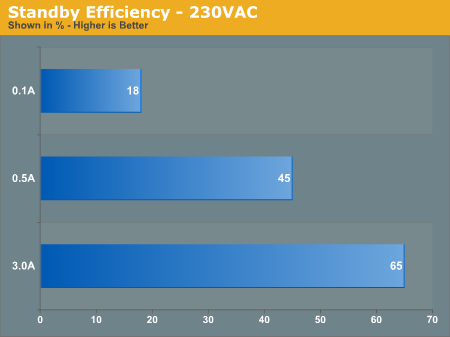
The standby efficiency is not quite what we have expected. We see very low results at the different loads and the power consumption while there is no load at all is very high: 1.57W (115VAC) and 2.13W (230VAC).
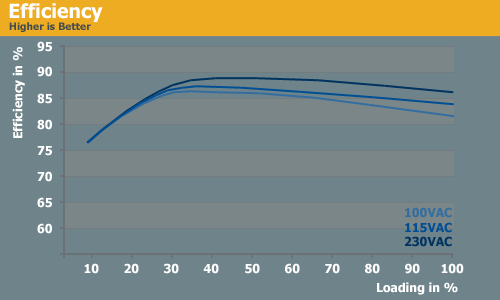
Zippy claims 86% efficiency on the box, but this is a very nice statement that we unfortunately see all the time. We were happily surprised in this case, as we have reached the same efficiency levels stated on the box. With 115VAC (like Zippy most likely has in Taiwan as well) we measure 86% efficiency. Since we know that with rising input voltages the efficiency rises as well, we can of course achieve even higher efficiency ratings. At room temperatures and 230VAC we got an incredibly high efficiency of 88.71%. That's the highest score we have seen so far. Good results can be achieved starting at just around 100W. The best efficiency will be gained by pulling a little more than 200W out of this power supply.
Power Factor Correction
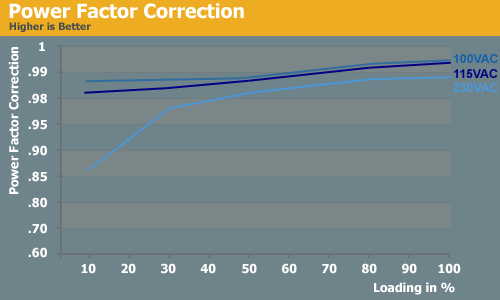
With lower input voltages we once again have very good results. With 230VAC it was a little bit odd that it started at such a low result of just .85 and needed 200W to gain an acceptable result. The trade-off between efficiency and PFC due to input voltage is a topic that can be (and has been) debated for a long time, and since the reality is that you'll be stuck with whatever voltage the country you live in uses, we won't get too hung up on it.
Temperatures
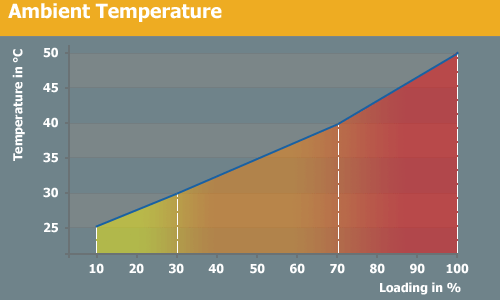
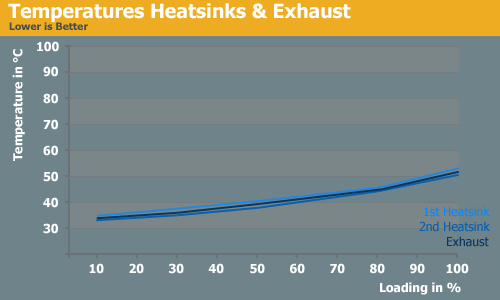
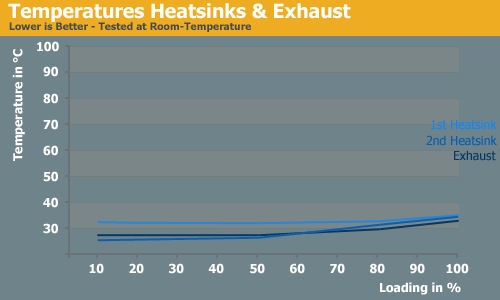
Throughout testing, the temperature of the heatsinks remains very low. The inside of the power supply tends to hover around 5°C above the ambient temperature. This means that the heatsinks are not getting hot at all and in addition they can easily dissipate the heat to the air.
Fan Speed
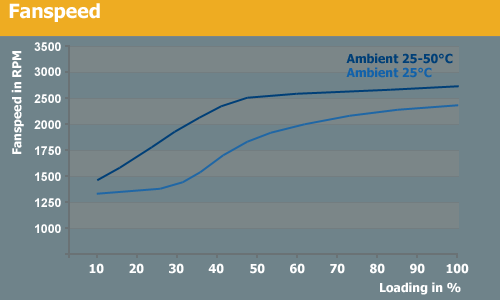
However, the low heatsink temperature results in a large part from the high fan RPMs. If Zippy wants to create a better power supply for the mainstream they definitely need to focus a bit more on fan selection and speed. Since the heatsinks and thus the inside of the power supply are not getting too hot, it should be possible to run the fan at much lower speeds for this PSU. The maximum fan speed tops out at over 2500 RPM, and at room temperatures it's not much lower, which certainly appears to be more than is required for this environment.
Acoustics
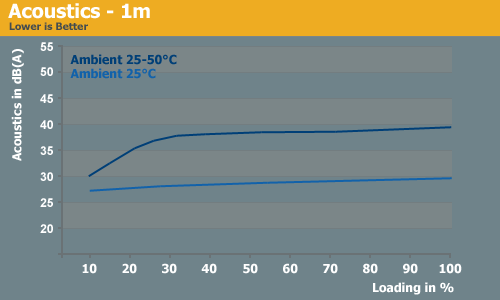
The noise levels are not particularly bothersome, but they are nevertheless clearly noticeable. If you mount the power supply in a decent midrange to high-end system you will probably not have any problem with the noise, since graphics card and CPU cooler will contribute a fair amount to noise levels as well. In comparison with previously reviewed products from Zippy and PCP&C, we can say it is definitely quieter. Does this power supply provide a feeling of serenity? We might not go that far, but at least it didn't annoy us.
Conclusion
The Serene is slightly comparable to the G1. While the G1 focuses on high-end gamers with the need of stability and reliability, the Serene offers almost the same but with a much higher efficiency. We see no reason why a user should choose the G1 when he can have the Serene. However, a big issue at the moment is availability. We have simply found no retailer in the world who offers the Serene and Zippy has not been much of a help so far. When/if we get an update on the availability we will post it here.
Assuming the availability issue is addressed, the Serene is a very good power supply with the best quality possible in the areas of design and components. The cables are long enough for most cases, and we only wish Zippy would have provided a little more choice on the PEG connectors since a 600W power supply is able to power up more than a single video card. The single 45A 12V rail should be able to handle high-end cards without difficulty, but many of those are beginning to require 8-pin connections, and we expect the next generation GPUs will increase that trend.
The DC outputs are quite similar to those of the G1. We did not see any flaw in this area, since none of the rails went out of specs even at higher loads and temperatures. The 12V rail is a little worse than the G1, but it's still close enough to the ideal result that it shouldn't present any problems.
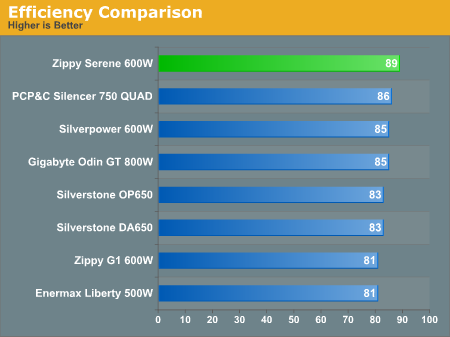
As for the efficiency, the numbers show a clear statement: the Zippy Serene has the best efficiency available in the retail market (at least, once it becomes available). We felt it was strange that the Serene wasn't able to show a better efficiency in standby mode, as it required up to 2.13W with no load at all. However, while that result is disappointing we must admit that high efficiencies at very low power draws aren't nearly as important as efficiencies at high power draws. After all, a 5% difference in efficiency at 200W works out to an extra 10W of power, which of course also means more heat that the power supply would have to dissipate.
It was good to see that Zippy at least used a lower rated fan for the Serene since it's just not as hot as the G1. With up to 39dB(A) it's clearly not suitable for ultra silent systems, even though the high efficiency makes it an attractive option for those systems. We are sure users could change the fan if desired, but in that case they need to be willing to void the warranty. As it stands, we just don't feel the power supply gets hot enough to require such a high RPM fan.
Another possible flaw in the design is the crowded internals of the PSU. If the housing were just a little longer the components would have more space to get air. We would expect higher turbulence because of the topology since most of the components are located directly inside of the airflow. This can also contribute to noise levels, as turbulence implies wind noise. However, the heatsinks are well placed and benefit from the air coming through.
Since we couldn't find this power supply for sale at the moment we are still waiting for Zippy to give us a rough price range. It will most likely be at the same level or slightly higher than the G1, considering the higher efficiency rating. If that's correct, prices will likely be in the $170+ range, which is a lot to pay for a 600W PSU. On the other hand, the Zippy Serene is one of the best power supplies we have seen so far and should bring very stable and reliable service to any owners.







